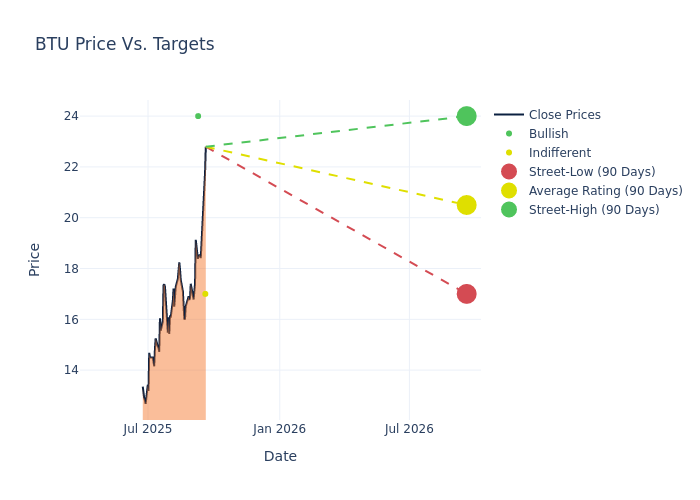Beyond The Numbers: 4 Analysts Discuss Peabody Energy Stock
Author: Benzinga Insights | September 19, 2025 04:01pm
Peabody Energy (NYSE:BTU) has been analyzed by 4 analysts in the last three months, revealing a diverse range of perspectives from bullish to bearish.
The table below summarizes their recent ratings, showcasing the evolving sentiments within the past 30 days and comparing them to the preceding months.
|
Bullish |
Somewhat Bullish |
Indifferent |
Somewhat Bearish |
Bearish |
| Total Ratings |
1 |
0 |
3 |
0 |
0 |
| Last 30D |
0 |
0 |
1 |
0 |
0 |
| 1M Ago |
1 |
0 |
1 |
0 |
0 |
| 2M Ago |
0 |
0 |
0 |
0 |
0 |
| 3M Ago |
0 |
0 |
1 |
0 |
0 |
Analysts' evaluations of 12-month price targets offer additional insights, showcasing an average target of $17.62, with a high estimate of $24.00 and a low estimate of $14.00. Observing a 10.13% increase, the current average has risen from the previous average price target of $16.00.

Interpreting Analyst Ratings: A Closer Look
A clear picture of Peabody Energy's perception among financial experts is painted with a thorough analysis of recent analyst actions. The summary below outlines key analysts, their recent evaluations, and adjustments to ratings and price targets.
| Analyst |
Analyst Firm |
Action Taken |
Rating |
Current Price Target |
Prior Price Target |
| Myles Allsop |
UBS |
Raises |
Neutral |
$17.00 |
$16.00 |
| Lucas Pipes |
B. Riley Securities |
Raises |
Buy |
$24.00 |
$18.00 |
| Myles Allsop |
UBS |
Raises |
Neutral |
$15.50 |
$14.00 |
| Myles Allsop |
UBS |
Announces |
Neutral |
$14.00 |
- |
Key Insights:
- Action Taken: Analysts adapt their recommendations to changing market conditions and company performance. Whether they 'Maintain', 'Raise' or 'Lower' their stance, it reflects their response to recent developments related to Peabody Energy. This information provides a snapshot of how analysts perceive the current state of the company.
- Rating: Unveiling insights, analysts deliver qualitative insights into stock performance, from 'Outperform' to 'Underperform'. These ratings convey expectations for the relative performance of Peabody Energy compared to the broader market.
- Price Targets: Analysts predict movements in price targets, offering estimates for Peabody Energy's future value. Examining the current and prior targets offers insights into analysts' evolving expectations.
For valuable insights into Peabody Energy's market performance, consider these analyst evaluations alongside crucial financial indicators. Stay well-informed and make prudent decisions using our Ratings Table.
Stay up to date on Peabody Energy analyst ratings.
All You Need to Know About Peabody Energy
Peabody Energy Corp is a producer of metallurgical and thermal coal. It also markets and brokers coal, both as principal and agent, and trades coal and freight-related contracts. The company operates in the following segment: Seaborne Thermal, Seaborne Metallurgical, Powder River Basin, Other U.S. Thermal and Corporate and Other. The Seaborne Thermal segment generates the majority of the revenue for the company. A substantial part of its overall revenue is generated from its customers in the United States, and rest from Japan, China, Australia, Taiwan and other regions.
Peabody Energy: A Financial Overview
Market Capitalization Analysis: Falling below industry benchmarks, the company's market capitalization reflects a reduced size compared to peers. This positioning may be influenced by factors such as growth expectations or operational capacity.
Revenue Challenges: Peabody Energy's revenue growth over 3M faced difficulties. As of 30 June, 2025, the company experienced a decline of approximately -14.58%. This indicates a decrease in top-line earnings. In comparison to its industry peers, the company trails behind with a growth rate lower than the average among peers in the Energy sector.
Net Margin: The company's net margin is a standout performer, exceeding industry averages. With an impressive net margin of -3.1%, the company showcases strong profitability and effective cost control.
Return on Equity (ROE): Peabody Energy's ROE is below industry standards, pointing towards difficulties in efficiently utilizing equity capital. With an ROE of -0.76%, the company may encounter challenges in delivering satisfactory returns for shareholders.
Return on Assets (ROA): Peabody Energy's ROA lags behind industry averages, suggesting challenges in maximizing returns from its assets. With an ROA of -0.48%, the company may face hurdles in achieving optimal financial performance.
Debt Management: Peabody Energy's debt-to-equity ratio is below industry norms, indicating a sound financial structure with a ratio of 0.11.
Analyst Ratings: Simplified
Benzinga tracks 150 analyst firms and reports on their stock expectations. Analysts typically arrive at their conclusions by predicting how much money a company will make in the future, usually the upcoming five years, and how risky or predictable that company's revenue streams are.
Analysts attend company conference calls and meetings, research company financial statements, and communicate with insiders to publish their ratings on stocks. Analysts typically rate each stock once per quarter or whenever the company has a major update.
Analysts may supplement their ratings with predictions for metrics like growth estimates, earnings, and revenue, offering investors a more comprehensive outlook. However, investors should be mindful that analysts, like any human, can have subjective perspectives influencing their forecasts.
Which Stocks Are Analysts Recommending Now?
Benzinga Edge gives you instant access to all major analyst upgrades, downgrades, and price targets. Sort by accuracy, upside potential, and more. Click here to stay ahead of the market.
This article was generated by Benzinga's automated content engine and reviewed by an editor.
Posted In: BTU





